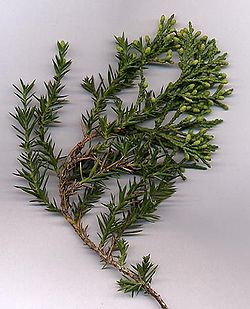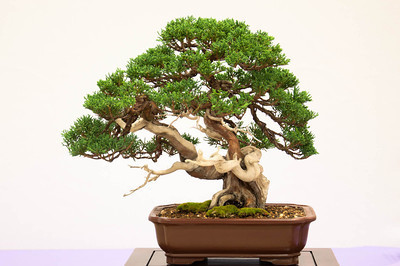
Juniperus chinensis first described in 1767, by Carl Linnaeus (or Carolus Linnaeus) (1707-1778), is commonly known as Chinese juniper or as Šœ†æŸ, 桧 (Yuan bai) in the Chinese language. This is an extremely popular horticultural species, possibly the commonest ornamental juniper.
Description. Chinese juniper is an evergreen coniferous species of shrub or tree with a very variable shape, reaching mature heights of 3 to 60 feet (1 - 20 m) tall. The leaves grow in two forms, juvenile needle-like leaves 0.2 to 0.4 inch (5 - 10 mm) long, and adult scale-leaves 0.06 to 0.12 inch (1.5 - 3 mm) long. Mature trees usually continue to bear some juvenile foliage as well as adult, particularly on shaded shoots low in the crown. This largely species often has dioecious either male and female plants, but some individual plants produce both sexes of flowers. The Blue-black berry-like seed cones grow to 0.28 to 0.5 inch (7 - 12 mm) in diameter, with a whitish waxy bloom, each containing 2 to 4 seeds; they mature about 18 months after pollination. The pollen cones, 0.08 to 0.16 inch (2 - 4 mm) long, shed their pollen in early spring.
Distribution. This species is native to China - Anhui, Fujian, Gansu, Guangdong, Guangxi, Guizhou, Hebei, Heilongjiang, Henan, Hubei, Hunan, Jiangsu, Jiangxi, Nei Mongol, Shaanxi, Shandong, Shanxi, Sichuan, Yunnan, and Zhejiang provinces; Taiwan; Japan; Korea; Myanmar; and Russia
This popular ornamental tree or shrub in gardens and parks has more than 100 named cultivars selected for various characters, such as yellow foliage (e.g. cvs.'Aurea', 'Tremonia'), permanently juvenile foliage (e.g. cv.'Shoosmith'), columnar crown shape (cv. 'Columnaris'), abundant cones (e.g. cv.'Kaizuka'), etc. Chinese juniper, as a non-native species in the U.S., should not be used there in natural plantings. The cultivar 'Shimpaku' is a very important bonsai subject. The Chinese juniper is widely used in bonsai, both as individual plants, such as the 250-year-old "Omiya tree" in the Birmingham Botanical Gardens in the UK, and in groups, such as the well-known Goshin on display at the National Bonsai and Penjing Museum at the US National Arboretum.
The following cultivars have gained the Royal Horticultural Society Award of Garden Merit:-


